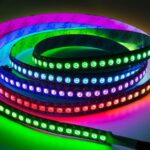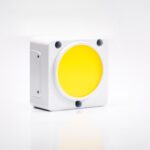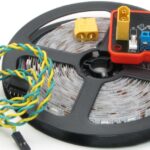
LED Garage Lights 101: Illuminating Your Workspace for Efficiency and Safety
LED Garage Lights 101, Your garage is more than just a parking spot; it’s a workshop, a storage unit, and sometimes even a makeshift gym. But without proper lighting, navigating this multi-purpose space can be a challenge. Enter LED garage lights—the modern solution for a bright, efficient, and safe workspace.
This comprehensive guide dives into everything you need to know about LED garage lighting 101. This article enables you to understand the benefits of choosing the perfect fixtures and installation tips.
Why LED? Advantages Over Traditional Lighting
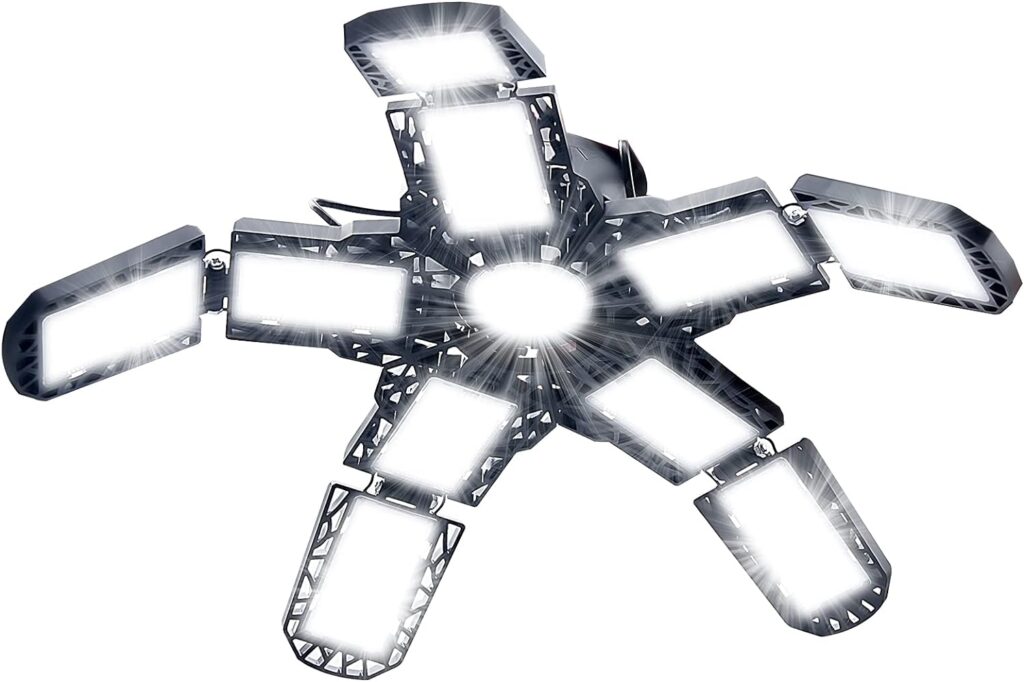
Traditionally, fluorescent lights have been the go-to option for garages. However, LED technology has emerged as the superior choice, offering a multitude of benefits:
Energy Efficiency:
LEDs are the undisputed champions of energy efficiency. They convert much more energy into light than fluorescents, resulting in significant savings on your electricity bill. An LED light can use up to 80% less energy than a fluorescent bulb, translating to real dollars saved over the long run.
Lifespan:
LED lights boast an incredibly long lifespan, often over 50,000 hours. This translates to years of worry-free illumination without the constant hassle of replacing burnt-out bulbs. Imagine the time and money saved compared to frequently replacing traditional bulbs!
Durability:
LED lights are built to withstand bumps and vibrations in a garage environment. Unlike their fragile fluorescent counterparts, LEDs do not have delicate filaments or glass tubes, making them ideal for areas prone to accidental contact.
Instant-On Lighting:
Unlike fluorescents, which take time to warm up, LEDs reach full brightness instantly. No more waiting around for your garage to illuminate—the light turns on exactly when you need it.
Heat Generation:
LED lights emit minimal heat compared to traditional bulbs. This is a significant benefit in garages, where temperatures can soar during hot summers. Less heat means a more comfortable workspace, especially if you spend extended periods working in your garage.
Environmentally Friendly:
Unlike fluorescent bulbs, LEDs are free of mercury and other harmful chemicals. Additionally, their lower energy consumption reduces your overall carbon footprint.
Versatility:
LED garage lights come in various styles, color temperatures, and lumen outputs, allowing you to customize the lighting to suit your needs. There’s an LED solution, whether you require bright overhead lighting for general tasks or focused task lighting for your workbench.
Types of LED Garage Lights:With the knowledge of lumens in hand, let’s explore the different types of LED garage lights available:
- Shop Lights: These linear fixtures are ideal for general overhead lighting. They come in various lengths and offer high-lumen outputs, perfect for illuminating the entire garage space.
- Deformable/Utility Lights: These lights often feature adjustable panels and provide exceptional versatility. The panels’ angle can be adjusted to direct light where you need it most, making them ideal for large and cluttered garages.
- Tube Lights: Replacing traditional fluorescent tubes with LED alternatives is a cost-effective and energy-efficient upgrade. They offer a familiar form factor with the benefits of LED technology.
- Cob Lights: These high-powered LED fixtures provide a concentrated light beam, perfect for task lighting applications like workbench or detailing areas.
- Strip Lights: LED strips offer a flexible lighting solution. They can be mounted along walls, cabinets, or lights themselves, providing task or accent lighting. They’re also a popular choice for creating a modern aesthetic.
Choosing the Right LED Garage Lights 101
With the vast array of LED garage lights, selecting the right ones can feel overwhelming. Here are some key factors to consider:
- Garage Size: The size of your garage directly impacts the amount of light you’ll need. More oversized garages require more lumens (light output units) for adequate illumination. A standard single-car garage (around 280 square feet) might require roughly 14,000 lumens, while a more oversized two-car garage (around 420 square feet) could necessitate closer to 20,000 lumens.
- Light Distribution: Consider how you’ll be using your garage. If you need uniform light for general tasks like parking your car or moving around freely, multiple lights with a broader distribution pattern might be best. A directional light with a narrower beam would be more suitable for focused task lighting over a workbench.
- Color Temperature: Color temperature refers to the “warmth” or “coolness” of the light. Warm white (around 3000K) offers a more inviting atmosphere, while cool white (around 4000K) provides a brighter, more energizing light. Daylight (around 5000K) is ideal for tasks requiring high color accuracy, like painting or auto detailing.
- Mounting Options: LED garage lights come in various mounting styles, including flush mount, pendant, and shop lights. Flush-mount lights are ideal for low ceilings, while pendants offer greater adjustability. Shop lights provide excellent overall illumination for oversized garages.
- Dimming Capability: Dimmable LED lights offer increased control over the lighting ambiance. This is particularly useful if you use your garage for multiple purposes, allowing you to adjust the brightness based on the activity.
- Motion Sensors: Motion-sensor-activated LED lights are a great energy-saving option. They automatically turn on when motion is detected and turn off when no movement is present, maximizing efficiency and security.
- Intelligent Features: Some LED garage lights incorporate innovative technology, allowing control via your smartphone or voice assistant. This enables you to remotely adjust lighting settings or schedule automatic on/off times.
Considering Motion Sensors and Smart Controls
Motion sensors add a layer of convenience and energy savings to your LED garage lighting. These sensors detect movement, automatically turn the lights on when someone enters the garage, and turn them off after a set period of inactivity. This eliminates the need to fumble for a switch in a dark space and reduces energy consumption by ensuring lights aren’t left on unnecessarily.
For those seeking the pinnacle of convenience and energy efficiency, delve into the world of smart LED garage lights. These lights seamlessly integrate with smart home systems, opening up a realm of possibilities. Imagine controlling your garage lights remotely using your smartphone or voice commands. You can adjust brightness, set schedules, and even group lights together for coordinated control, all from the comfort of your home.
Installation Essentials
While some LED garage lights are designed for easy DIY installation, consulting a qualified electrician is always recommended, especially for complex setups or if you’re unfamiliar with electrical work. However, if you’re comfortable with basic electrical tasks, here are some essential steps to ensure a smooth installation:
- Turn off the power to the circuit controlling your garage lights at the breaker box before starting work.
- You’ll likely need a screwdriver, wire strippers, pliers, a drill, and appropriate mounting hardware (usually included with the light fixture).
- Locate the existing light fixture or the desired location for your new lights. Ensure enough space for the fixture and proper clearance from any obstructions.
- Every LED light fixture comes with a specific installation guide. Carefully read and follow the instructions for your particular model to ensure a safe and proper installation.
- Match the colored wires of the new fixture to the corresponding wires in the existing electrical box using wire nuts. Double-check your connections before securing them.
- Turn the power back on at the breaker box and test your new LED lights. Once operational, securely fasten the fixture to the mounting location.
Maintaining Your LED Garage Lights 101
LED lights require minimal maintenance, but a few simple practices can extend their lifespan:
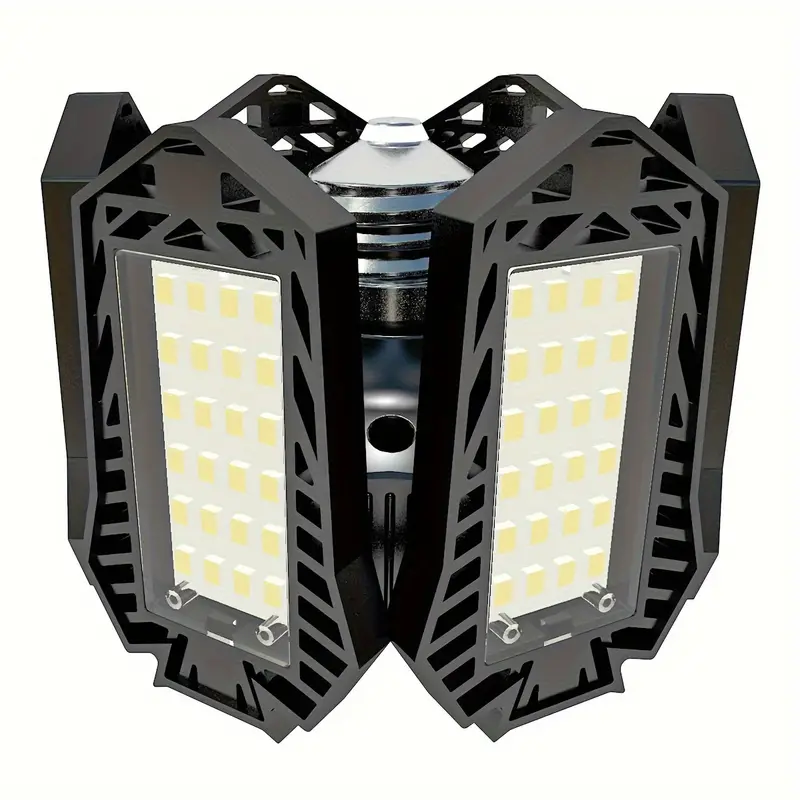
- Occasionally dust your LED lights with a dry microfiber cloth to maintain optimal light output.
- Use a damp microfiber cloth with a mild cleaning solution for stricter grime. Avoid harsh chemicals or abrasive cleaners that can damage the light fixture.
- Visually inspect your LED lights periodically for any signs of damage or flickering. Address any issues promptly to prevent further problems.
Conclusion:
By switching to LED garage lights, you’re not just upgrading your illumination but making a wise investment. LED technology offers a winning combination for your garage, from significant energy savings and extended lifespan to improved safety and versatility. With the knowledge you’ve gained from this comprehensive guide, you’re well-equipped to choose the perfect LED lighting solution for your workspace, transforming your garage into a bright, efficient, and safe environment for all your needs.
FAQs
Q: How many lumens do I need for my garage?
A: The recommended starting point for general garage lighting is around 50 lumens per square foot (lm/ft²). However, this can vary depending on factors like ceiling height and the presence of windows. Consider additional task lighting for workbenches, requiring higher lumens for focused illumination.
Q: Can I install LED garage lights myself?
A: Some LED garage lights are designed for easy DIY installation. However, consulting a qualified electrician is always recommended, especially for complex setups or if you’re unfamiliar with electrical work.
Q: Do LED garage lights work in cold temperatures?
A: Unlike some fluorescent bulbs, most LED garage lights function well in cold environments. However, always check the specific temperature rating of the LED fixture you choose to ensure compatibility with your garage climate.
Q: Are there any dimming options available for LED garage lights?
A: Yes, certain LED garage lights offer dimming capabilities. These provide added control over the light intensity, allowing you to adjust the ambiance for different purposes. Look for dimmable fixtures compatible with your existing dimmer switches or smart home systems.
Q: Are LED garage lights eco-friendly?
A: Absolutely. LED lights are significantly more energy-efficient than traditional options, reducing your carbon footprint. Additionally, they contain no harmful mercury, making them a more eco-conscious lighting choice.


